Mark Ashton was an activist and campaigner in the 1980s, perhaps most known for co-founding Lesbians and Gays Support the Miners during the miners’ strike of 1984-85. He was a member the Communist Party of Great Britain, general secretary of the Young Communist League and joined Red Wedge, a collective of musicians aiming to engage young people with the Labour movement. Mark died of AIDS related illness in 1987. The Mark Ashton Trust was set up by a group of friends to respond to the ongoing crisis.
In this blog, filmmaker Ashtar Al Khirsan, one of the founding members of the Mark Ashton Trust, tells us about why the Trust was created and their aims to raise money at music events and club nights during the HIV/AIDs crisis. Ashtar was involved in campaigning and fundraising during the AIDS crisis in the 80s and 90s. Her current documentary project looks at the lives of people whose names are memorialised in the UK AIDS Quilt.
The Mark Ashton Trust (MAT) came out of a desire by a group of Mark’s friends to do something at a time of acute crisis. Mark was for most us, the first in our friendship group to die of an AIDS related illness. It felt particularly shocking as his death was very sudden. A visit to his GP and from there sent straight to hospital for an x-ray. Mark was kept in hospital and died two weeks later.
Mark had a lot of friends and I may just be speaking for myself but I think a lot of us wanted to keep his name out there and to stay connected to him in some way. I suspect setting up the Trust in his name was part of a grieving process as well as a need to respond to the impact that AIDS was having in the community. People got involved for different reasons but everyone had a love and respect for Mark.
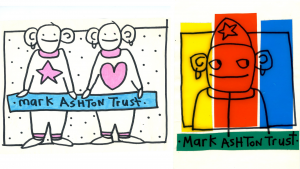
The MAT brought together people that Mark had known in Lesbians and Gays Support the Miners, the Communist Party and other friends that he had met outside of those groups. We had a core group of Trustees and fundraisers.

There was some discussion, and inevitable disagreements, at the early meetings about what our remit should be. Some thought that we should be more of a political campaign but the thinking amongst most in the group was that we should exist to provide direct support for people who were in financial need. There was a feeling that we wanted to impact people in the community who had HIV/AIDS and needed support quickly without filling in forms or waiting for funding to be granted. If you wrote to the Mark Ashton Trust and you needed support urgently, we could help with that. There were larger organisations at that time, such as the Terrence Higgins Trust and support groups like Body Positive and Frontliners. We thought that the MAT could do something slightly different or complimentary to those groups.
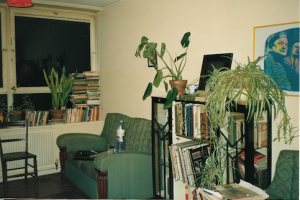
The Trusts ‘office’ or base was at 160, Claydon House in the flat I shared with Mark and we held all our Trustee meetings there.
To apply for funds, we asked people to write to the Trust and the letters were both heart-breaking and anger-inducing. It was clear that there was intense hardship and isolation for many living with HIV and AIDS and people often found help and support by the state difficult to access.
Sometimes the letters would come direct from someone who was ill and other times they would come from Social Workers or Buddys. People would write letters asking for help with basic items, a fridge, washing machine, heating and things like bed linen. The hardship for many was intense.
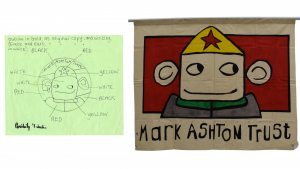
To raise funds, we decided to create tee-shirts and badges. Diane Pacey’s name came up as a designer. Diane had created artwork for The Communards album. Hugo Irwin, who was an important member of the Trust, suggested her. Diane designed the tee-shirts, badges and banners, she gave the Trust such a strong visual identity and her logo helped raise thousands of pounds in merchandise. I remember Diane coming to the flat and showing me the first designs for the tee-shirt. Diane told me she wanted to capture the essence of what Mark looked like and settled on his ears which she depicted in a way that made the logo immediately identifiable as Mark to anyone who knew him. Diane’s work has a naivety and simplicity, it seemed childlike and it captured something that was perfect for a time when LGBT+ people and anyone with HIV/AIDS was seen as a threat to the rest of the population.
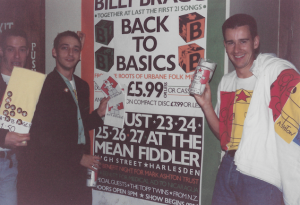
To raise money, we piggy backed onto a lot of music events and gigs. I had met Mark at Red Wedge and so had some contacts with musicians and Mark had been a longstanding friend of Jimmy Somerville’s. The Communards were the first band to perform gigs in aid of the Mark Ashton Trust. After that we would approach bands or artists and ask if we could sell our merchandise at their gigs – nearly everyone said yes. So, we would set up a stall in the foyer and at the end of the gig we would shake buckets as people left.
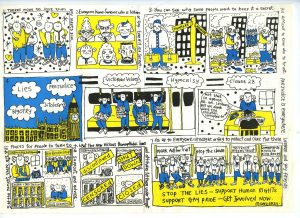
We also put on some club nights and asked various soap stars to come along and DJ. Sue Johnson from Brookside was a particular favourite in the LGBT+ community at the time and always very supportive of the MAT.
Aside from the direct grants, we also produced a couple of safe sex leaflets and Stop the Clause leaflets. Although other organisations were doing this work we saw it as part of the Trust’s education and information remit. Diane Pacey also designed these leaflets which we ambitiously wanted to hand out to young people at the school gates but we could never get permission.
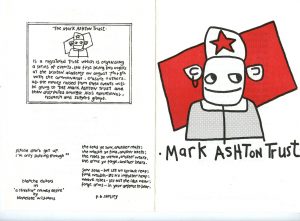
By the time we wound the Trust down in 1989, we had raised more than £18,000. The Trust helped many people who were HIV positive or had AIDS and were in financial hardship and perhaps also Mark’s friends who came together as group at a time of intense personal loss.
Filmmaker Ashtar Al Khirsan was one of the founding members of the Mark Ashton Trust.
Guest blogs are not curated by PHM but feature voices on topics relevant to the museum’s collection. Guest blogs do not necessarily reflect the views of PHM. Images supplied by contributor.
Follow the Mark Ashton Trust Facebook page.
Visit the Labour History Archive at PHM to explore the Mark Ashton collection and Lesbians and Gays Support the Miners collection.
Watch PHM’s Conservator Kloe discuss the Lesbians and Gays Support the Miners banner, made by Mark Ashton around 1984. The banner was last on display in our 2022 Banner Exhibition.
Subscribe to PHM’s regular e-newsletter to keep up to date with PHM’s latest blogs and upcoming events, by taking the Radicals quiz.